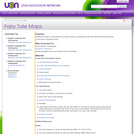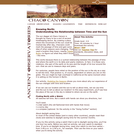
Cardinal Directions
Description:
- Subject:
- Arts and Humanities
- Languages
- Material Type:
- Lesson
- Date Added:
- 09/20/2018

Cardinal Directions
Description:

Students explore the many different ways that engineers provide natural lighting to interior spaces. They analyze various methods of daylighting by constructing model houses from foam core board and simulating the sun with a desk lamp. Teams design a daylighting system for their model houses based on their observations and calculations of the optimal use of available sunlight to their structure.

Students will begin to understand the concept of maps by describing the path that Little Red Riding Hood took on the way to Grandma's house. Main Curriculum Tie: Social Studies - Kindergarten, Standard 3 Objective 1, Identify geographic terms that describe their surroundings. Many fairy tales and nursery rhymes take the characters on a path through the rhyme/story. In this lesson, we will be making up maps for the characters to follow. In the first activity, the class will be recreating a map of the path that Little Red Riding Hood takes to Grandma’s house. The students will be exploring basic map directions and characteristics.

Students create their own simple compasses using thread, needle and water in a bowl and learn how it works.

This activity shows how our experience of the Sun changes with time and location. The sun dagger at Chaco Canyon is thought by many to be a sort of ancient timekeeping device. By creating a place where the movement of the Sun could be tracked day after day, Chacoans could mark the passage of time and gain an idea of when seasons were changing. If the Chacoans could use a particular location and the Sun to tell them about time, can we use time and the Sun to tell us about our location? In this easy experiment, you'll see how the position of the Sun in the sky is related to where we are on the earth.

In this lesson, students are shown the very basics of navigation. The concepts of relative and absolute location, latitude, longitude and cardinal directions are discussed, as well as the use and principles of a map and compass.